Explainer
- Explainer
- Russia-Ukraine war
What does Putin want in Ukraine?
Europe is locked in a stand-off reminiscent of the Cold War. Why is Russia threatening Ukraine and what does it mean for NATO - and the rest of the world?
By Sherryn Groch and Chris Zappone
The message flashed across screens at the Ukrainian government offices, as days of peace talks between Russia and the West hit an impasse: “Be afraid and expect the worst. This is for your past, present and future.”
It might have been a small-scale hack last month, rather than another dreaded wave of power station shutdowns. But for Ukrainians already eight years into an undeclared war with Russia and watching 100,000 Kremlin troops line up at the border, the message was loud and clear.
Russia has had a starring role in some of Ukraine’s biggest international crises down the years, from crippling cyber attacks to war for territory in the east. Now, US and Ukrainian intelligence say they have uncovered plans for a major Russian invasion in early 2022.
They believe Kremlin saboteurs have already infiltrated Ukraine to sow violence and create a pretext to roll in troops, as Russian state television blasts fake news of a Ukrainian plot against Russia, and Microsoft warns of more malware lying in wait inside Ukrainian networks.
Officially, Russia has denied it intends to invade while the US and the UK are already sending weapons to Ukraine.
What is the Kremlin after? What could happen if diplomacy fails? And what does it mean for the rest of the world?
What do we know about Ukraine?
With Russia at its back, a clutch of NATO countries to the west and the Black Sea on its doorstep, Ukraine has become the epicentre of the Kremlin’s fight to keep control of eastern Europe. It’s the largest country in the region, save Russia itself, known for its mountains and festivals (including a national week dedicated to eating pancakes) and home to the third-largest military in Europe.
A country rich in natural resources, once called the USSR’s breadbasket, Ukraine is also a country of deep poverty, with a dark history of environmental catastrophe under the Soviets – from the deadly Holodomor famine orchestrated by Stalin-era control of farms to the Chernobyl nuclear power plant meltdown near the border with Belarus in 1986.
Ukrainian language and traditions were largely destroyed during the country’s long years under foreign powers, says Kyiv-based artist Hanna Kovalska. But she says more and more people are switching back to their own language and way of life. And that, in turn, has provoked a heavier crackdown from Moscow.
To Putin, Ukraine is still part of Russia and it cannot fall to the West. For much of eastern Europe, it’s also a red line. If Russia reclaims one ex-Soviet state, will it come for them next?
“Ukrainians have the resistance in their blood,” says Marta Barandiy of Promote Ukraine, a Brussels-based non-profit that supports EU-Ukraine ties. “All those centuries fighting for freedom and autonomy from all the neighbours left a scar on the soul of many generations.”
In 2019, in a strange case of life imitating art, the star of a popular TV comedy about an everyday man becoming the Ukrainian president was himself actually elected president of Ukraine. Since his landslide win, Volodymyr Zelensky has had mixed reviews, praised for some elements of his pandemic response. But, Kovalaska says, his promises to clean up corruption in Ukrainian politics and end the war with Russian separatists are so far unfulfilled – “the miracle has not happened” – and his popularity is now slumping.
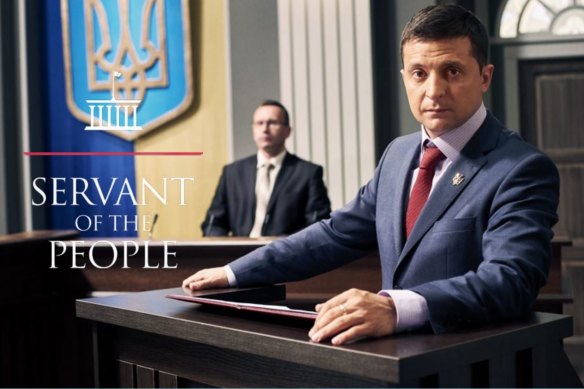
Comedian Volodymyr Zelensky starred in the popular “Servant of the People” before he was elected Ukraine’s president.Credit: Kvartal 95
What is Ukraine’s relationship with Russia?
Ukraine’s capital, Kyiv, is considered the birthplace of the Rus empire (originally made up of Vikings) that became modern Russia. There are still deep cultural ties to Russia, but most Ukrainians consider themselves a separate people. Ukraine is not as entangled as neighbouring Belarus is with Russia, for example. There, the country’s militaries are joined, and people speak Russian more than their own language. After the collapse of the Soviet Union in 1991, Russia had pledged not to interfere in a newly independent Ukraine.
Then, in late 2013, when Ukraine’s then pro-Kremlin president Viktor Yanukovych refused to sign up to a trade association with the European Union, street protests in Kyiv erupted into what became known as the Maidan (after the city’s central square where protesters set up barricades). The rebellion revealed a deep rupture in Ukrainian society between those still deeply tied to Russia and those eager to throw off the old Soviet legacy to embrace opportunities from the West. That winter, hundreds of statues of the Russian leader Lenin were toppled and defaced in what became known as “Leninfall” – and Yanukovych fled.
The Kremlin, long fearful of what Russia expert Dr Robert Horvath calls “revolution contagion”, acted fast. Within days, Putin’s “little green men” (soldiers without insignia) were invading Crimea in unmarked tanks. Moscow installed a Russian politician (with rumoured mob ties and the mafia nickname The Goblin) as head of the new “republic” to force through a stage-managed referendum to separate from Ukraine. It was not recognised by the West and both Crimea and breakaway rebel provinces in the east now held by pro-Russian separatists have become international no-fly zones.
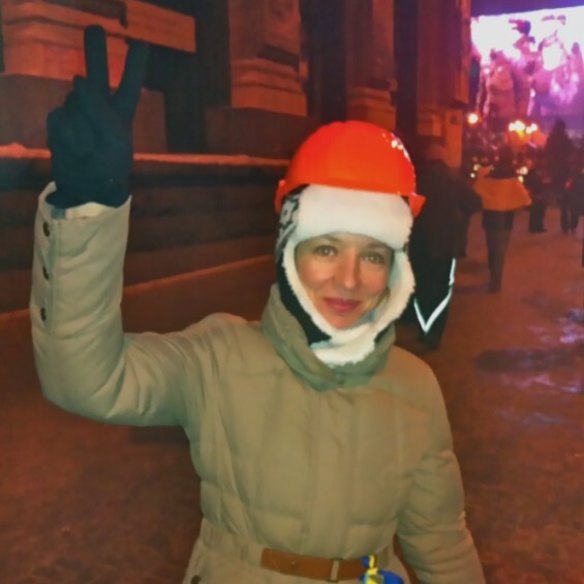
Hanna Kovalska during the Maidan revolution in 2013.
Since that war broke out, about 15,000 people have been killed, including 298 passengers on commercial flight MH17 that was shot down during the fighting in July 2014 (38 of them Australian citizens and residents).
A shaky ceasefire brokered in 2015 by Germany and France has helped end large-scale battles but left the conflict frozen in a tense stand-off, where sniper fire still crackles on and off along the line and attacks in cyberspace rage on. Since the latest uptick in tension, emergency talks between the West and Russia have resumed.
Many experts have compared Russia’s focus on Ukraine to China’s efforts to reclaim Taiwan. Both are testing grounds for attacks – and flash points for conflict with the West.
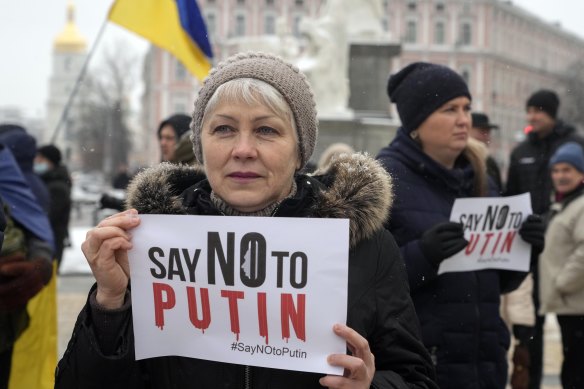
Activists hold posters during a SayNOtoPutin rally in Kiev, Ukraine, on January 9, 2022.Credit: AP
Why might Russia want to invade Ukraine?
This year will mark 100 years since the creation of the Soviet Union. Putin calls its collapse in 1991 “a major geopolitical disaster”, which saw Russia lose “40 per cent of our territory”.
Russia is still a formidable military power (the US and Russia hold 90 per cent of the world’s nuclear arsenal between them), and much of Europe relies on it for energy. But it is increasingly overshadowed by the rise of economic superpower China.
Putin wants to restore Russia to some of its former glory, says Dr John Besemeres, a Russia expert and former Australian intelligence analyst now at the ANU. The Russian President has made no secret of his “imperial ambitions” to reclaim the old Soviet states, Besemeres says. Russia, without natural borders such as rivers and mountains along its western frontier, sees a “sphere of influence” over its neighbours as its best defence. “And he is determined, in particular, to take over Ukraine,” Besemeres says.
Annexing Crimea in 2014 became a kind of revenge for the perceived wrongs done to Russia by the West. “If you compress a spring all the way to its limit it will snap back hard,” Putin said at the time, and his popularity back home soared to record highs.
There are precedents. The Soviets twice invaded their own nominal Cold War allies when they became nervous about the direction of politics in Hungary (1956) and the then-Czechoslovakia (1968).
“The history of Russia is the history of imperial expansion,” says the ANU’s Kyle Wilson, a former diplomat to Moscow.
Retaliatory sanctions from the West after Crimea stung, but NATO (including its key member the US) did not send troops to Ukraine’s defence, and many experts say Putin was emboldened.
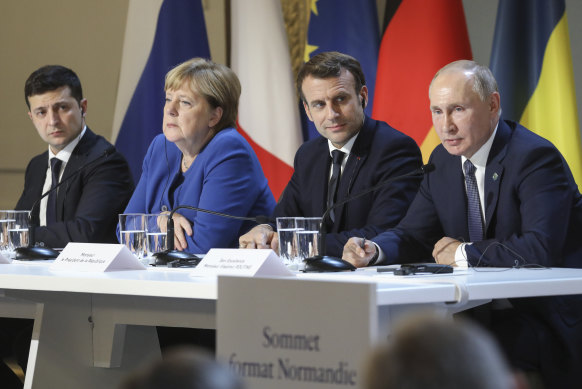
Ukraine’s President Volodymyr Zelenskiy, left, German Chancellor Angela Merkel, French President Emmanuel Macron and Russian President Vladimir Putin, right, in Paris during 2019 peace talks on the Ukrainian-Russian conflict.Credit: AFP
Is this really a showdown with NATO?
Putin questions why NATO, the North Atlantic Treaty Organisation formed after World War II to safeguard peace in Europe (and contain the Soviet Union), has continued to expand since the Soviet Union broke apart.
And this time his demands are big – he doesn’t just want NATO to disavow talk of Ukraine ever joining its military alliance, he wants them to pull back their forces from Eastern Europe, effectively rewriting the old boundaries agreed in 1997.
That year, Moscow entered into an agreement with NATO that made clear ex-Soviet states could join the Western alliance and, since then, more than a dozen countries in the region have become NATO members, including the former Soviet Baltic republics Estonia, Latvia, and Lithuania in 2004.
Four years later, NATO declared its intent to bring Ukraine, Georgia and Moldova into the fold and Moscow said a red line had been crossed. Russia now has “nowhere further to retreat to”, Putin has complained. “Do they think we’ll just sit idly by?”
During Montenegro’s bid to join NATO, the tiny nation accused the Kremlin of involvement in a 2016 failed coup and assassination plot against its prime minister. (Two Russian secret-service agents were later convicted in absentia over the thwarted plans, but Montenegro did join NATO.)
In 2008, America lobbied to let Ukraine and Georgia into the alliance but was blocked by Germany. In the years after, both Georgia and Ukraine were invaded by Russian troops.
“Russia’s demand is this,” says Wilson. “Russia claims no state should seek its security at the cost of the insecurity of others. But that is actually what they’re doing ... They believe their neighbours must be weak and neutral while Russia can be a military superpower.”
If Ukraine does join NATO, it will be afforded the full protections of the alliance – member countries will be bound to defend it if it comes under attack. Of course, Horvath says, that’s unlikely to happen any time soon. “NATO decision-making is by consensus, and it will be a very long time before all of its member states agree.”
Meanwhile, Ukraine is caught in a sort of tug-of-war between East and West, a grey zone “where Russian influence ends and Western influence starts,” says Griffith University’s Dr Matt Sussex. “From Putin’s perspective, the Ukraine question has to be settled.“
And many experts say Putin has chosen his moment well. The world is still reeling from the pandemic and US President Joe Biden has just overseen a messy withdrawal from Afghanistan. Russia, which has now set up its own loose defence alliance in the region with Belarus, Armenia, Kazakhstan and Tajikistan, may be betting that the US is not of a mind to intervene in another long, messy conflict.
“But Europe cannot be defended without American support,” says Besemeres.
Sussex and Wilson say the border standoff is designed to test Ukraine’s connections with the West and to test Biden himself. “Putin has come to think Biden is weak (and preoccupied with domestic problems),” says Sussex.
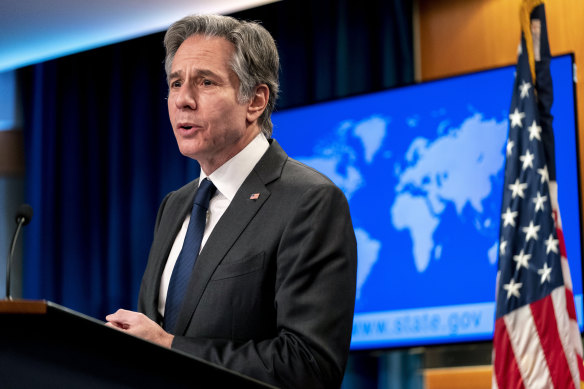
US Secretary of State Antony Blinken: “One lesson of recent history is that once Russians are in your house, it’s sometimes very difficult to get them to leave.”Credit: AP
What has been the response from NATO countries?
Peace talks have not been uncommon between Western leaders and Russia over Ukraine since fighting broke out. In April last year, a build-up of Russian troops at the border coincided perfectly with Putin’s push to meet the new President Biden in another “perfectly engineered crisis”, Besemeres says, “to make Biden agreeable to what Putin wanted from that summit”.
But this time, experts note his demands seem beyond the reach of compromise (and have so far been refused).
“Russia won’t accept Ukraine into NATO. The West won’t accept a Russian sphere of influence,” says Sussex.
US officials have, however, said that America is willing to deal with Russia on new arrangements around military exercises and tougher rules on nuclear weapons, which all sides still agree are off-limits).
In a sign of the evolving tone from Russia’s neighbours, in early January, NATO Secretary-General Jens Stoltenberg said the organisation would engage in talks with Russia in good faith, but warned: “We have troops, we have forces ... We have the plans to be able to defend, protect all allies … to make sure that we preserve peace in Europe.”
Ukrainian artist Kovalska, who took part in the Maidan protests, says sanctions should also be imposed on some Ukrainian oligarchs in the pocket of Moscow who profit from the chaos and enduring poverty of a Ukraine under siege. The longer Ukrainian democratic institutions falter, the stronger Moscow can spin the narrative of Ukraine as a failed state.
Yet, the global response so far may also have been a surprise for the Russian leader . Since the latest Ukraine crisis began, the US has sent anti-tank weapons and put thousands of troops in the US on stand-by for deployment to Eastern Europe. Baltic nations have sent arms to Ukraine. While Britain, a historical rival of Russia’s going back to the Crimean War, has openly discussed sending troops to the region. The US and allies have also discussed coordinated, and innovative sanctions aimed at Moscow if it chooses to invade. Australia has discussed aid to the country, and countries are withdrawing embassy families.
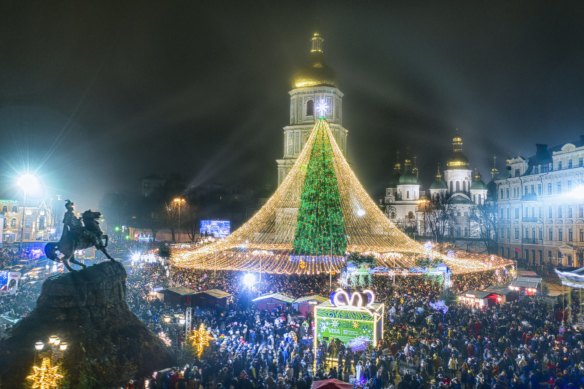
Crowds of people celebrate the New Year in Kyiv, Ukraine, on Jan. 1, 2021.Credit: AP/Efrem Lukatsky
What is the reaction in Ukraine?
Ukraine’s government has been noticeably sidelined from some of the recent peace talks, and forced to set up an informal channel with Moscow. (“It’s unacceptable, but there is no choice but to watch two states deciding the destiny of a third one,” says Barandiy). Ukrainian president Zelensky has said his country is ready to take the necessary decisions to end the war in Donbass. That could include more prisoner swaps and another ceasefire. While Ukraine has been calling on the West for help, the intensity of the attention from world leaders has also seen Zelensky move to dampen fears of an impeding invasion domestically, amid concerns the drums of war will spook investors and create panic).
Asked what Australia and other non-NATO countries could do to support Ukraine, Zelensky said: “Investors are welcome.”
Barandiy says most Ukrainians will not accept more appeasement of Moscow “because we know it does not work”. “I believe that no matter what the results of “the talks” are, Putin will not let Ukraine go: the more that is given in, the more he will want to take later, to restore ‘the empire’.”
Indeed, former Ukrainian minister of defence Andriy Zagorodnyuk argues that accommodations in the past by the West have only emboldened Putin to continue “negotiations at gunpoint”, ratcheting up the prospect of war.
Above: A meme posted by the Ukrainian government in late 2021 as Russian troops built up at the border.
Sussex agrees: “If you’re Putin, why not keep doing this? Because every time you do, you get rewarded. The Russians are prepared for a 25 per cent risk of war to achieve what they want on the border. So many wars are started by accident, particularly when someone decides to send a patrol close” to enemy lines.
The best way to avoid war now, Zagorodnyuk says, is to make the cost of a full-scale invasion too high for the Kremlin. Russia has built up its reserves in recent years and is well-placed to weather another storm of sanctions. Instead, he argues, a Russia waiting for the West to “blink first” in its dangerous diplomatic dance, should be reminded that a long, difficult occupation of Ukraine will not be popular back home, just as the Soviet invasion of Afghanistan in the 1980s was not.
“And Ukraine is not a helpless hostage”. It has an army of about 145,000 and there are 300,000 veterans of the long-running conflict in Donbass with Russian separatists. Polling says one in three Ukrainians are willing to take up “armed resistance” to an invasion.
The US is also considering supporting Ukrainian insurgents fighting against separatists in Russian-controlled territory too. It’s part of a so-called “Porcupine strategy”, laying down resistance as far across Ukraine as possible to make the country so spiky with threats it becomes too difficult for Russia to swallow.
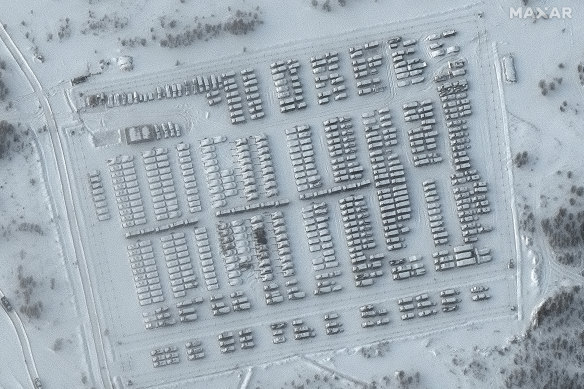
Battle group deployments at the Pogonovo training area in Voronezh, Russia, near Ukraine on January 19.Credit: Maxar Technologies
Will Russia really invade?
The signs are there on the ground, and they could be genuine preparation or pure theatre – or a little of both.
Even before talks had begun with the West this month, the Kremlin was emptying its Ukrainian embassy and issuing more than 500,000 passports to Russian separatists fighting in Ukrainian territory (so it can claim to be “coming to the defence of its citizens” if it invades).
Ukraine says the cyber attack that knocked its government websites offline this month came from Russia, Microsoft has issued a warning more malware is in place in the country’s networks, and on January 10, Ukraine arrested a Russian military intelligence agent allegedly trying to recruit others into terrorist attacks on the Ukrainian city of Odessa. The US said in January it gathered intelligence of “false flag” missions – operatives trained in urban warfare dispatched to sabotage Russia’s own proxy forces, and so provide Moscow with a cause for war.
Meanwhile, Kremlin ally Belarus has been running joint military drills with Russia near its own border with Ukraine, which leaves the besieged Ukraine facing troops on three sides. Moscow’s recent military intervention to put down uprisings in Kazakhstan has cemented Russia’s ties to that country’s forces too.
Just as it did before seizing Crimea, the Kremlin has also been flooding Ukraine with disinformation – ramping up the narrative that Russia must defend against “dangerous” Ukrainian nationalists.
Besemeres points to a “long and, frankly, horribly tedious” essay Putin himself wrote last year claiming there was no distinction between Ukrainians and Russians; therefore Ukraine could not be its own country. “And they’ve been making the army learn all this propaganda too,” he says. “Why? Well, those people might have to invade Ukraine at some point.”
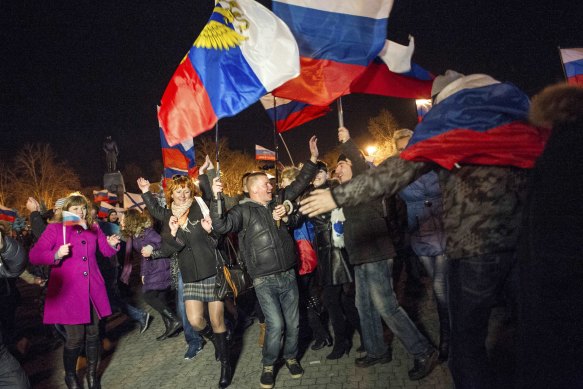
In Crimea, where about half the population is ethnically Russian, pro-Putin crowds celebrated the annexation in 2014.Credit: AP
If Putin wants to invade, he has a narrow window to move in this northern winter. The land at the border is expected to freeze by February, allowing tanks and other heavy military equipment to cross. If he waits into March, that ice will turn to mud. Experts expect he would need somewhere between 150,000 and 200,000 troops for a full invasion of Ukraine – on the scale of what the US and its allies sent into Iraq in 2003. As Russia itself learnt from Soviet incursions in the Middle East, that would be costly, messy and potentially damaging back home.
But Hovarth, like many seasoned observers of Russia, says “the danger is real” this time. ”Putin has already unleashed one war in Ukraine. He’s committed atrocities in Syria.”
And Horvath believes Putin’s motives are less about Russia’s interests than his own. Putin was a little-known secret service chief before he catapulted to power as the strong man launching a bloody war with neighbouring Chechnya. Annexing Crimea gave him another polling bump. But “it was a catastrophe for Russia’s long-term national interests. It turned a kindred people into an adversary, and guaranteed Ukraine’s Western trajectory.”
It’s an old trick of Putin’s, Horvath says, “aggression on the international stage is a way of shifting the focus”. And he says the ageing autocrat could use a distraction right now. The poisoning and jailing of his main critic Alexei Navalny, as well as Navalny’s exposes on Putin-era corruption, has drawn the wrong attention.
But if Russians suddenly cannot buy iPhones under fresh Western sanctions, or soldiers begin returning home in body bags because of an expensive war over the border, a messy war may backfire.
And the depth of the US and European response so far may have also altered Putin’s calculus over Ukraine.
Instead of seeking to take over all of the country, including Kyiv, Russia could stop at a larger slice of the east. Still, US officials have indicated they will treat any incursion at the border seriously. (How the US will respond to a major cyber offensive, of the kind that has knocked the lights out in Ukraine in the past, is less clear).
Also complicating the picture is the major Russian pipeline Nord Stream 2, which runs under the Baltic Sea to carry gas to Europe. When it opens, Russia will have more leverage over Germany and wider Europe – even if a lot German leadership does not see this as overly problematic.
The fate of “Europe’s most politically divisive infrastructure project” is now closely tied to Ukraine’s. If Russia invades, Germany, which has historically been reluctant to confront Russia on Ukraine, has hinted it will block the pipeline. “In the event of fresh aggression, we have a wide range of answers, including Nord Stream 2,” Annalena Baerbock, the German foreign minister, told Parliament on January 27. But if the pipeline opens and war hasn’t come, one of the last levers to pull Russia back from conflict will be gone.
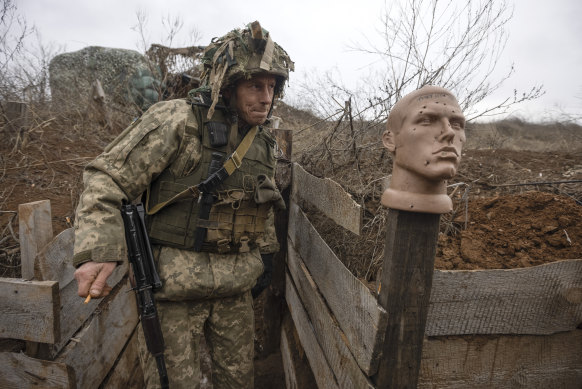
A Ukrainian soldier at the line of separation from pro-Russian rebels in the Donetsk region, Ukraine. Credit: AP
In 2014, Western governments were largely unprepared for the Kremlin disinformation offensive that accompanied their invasion of Crimea. But this time the White House is taking nothing from the Russians at face value. US Secretary of State Antony Blinken has accused Russia of pushing a “false narrative” that it itself is under threat from Ukraine and NATO to justify its troops at the border.
Sussex says there has “certainly” been an “evolution in approach” from the West on public communication with Russia. The question now is whether the US is “trying to pre-empt (and hence prevent) invasion with forewarning based on solid intelligence” or is the US actively trying to “shift the narrative” to put Russia on the defensive in the public sphere.
Indeed, all minds might be on the Kremlin, trying to anticipate Putin’s next move, but eastern Europe is looking just as anxiously at the US.
“A Russian invasion of Ukraine would be a humanitarian catastrophe and a disaster for Ukraine, for Russia, for Europe and the world,” says Horvath.
The Biden administration has made it clear that its response will be limited.
“When the bluff is called,” the West will have to decide what to do, says Sussex.
By then, he says, Putin will have succeeded in further eroding the post-Cold War order. With news of the talks in the headlines, some Western commentators and members of the public are asking, “‘Why should we be involved in Ukraine?’ Partisans, hard-core realists, isolationists all ask: what does eastern Europe mean to us? [And] if you’re Poland or a member of a Baltic state, you’re terrified.”
Barandiy says Ukraine is used to being let down by the West. “Even if the West does not help Ukraine now, Ukrainians will still rise,” she says.
“But that will be the final fight and the independence that we gain, will be the real one – from the West as well.”
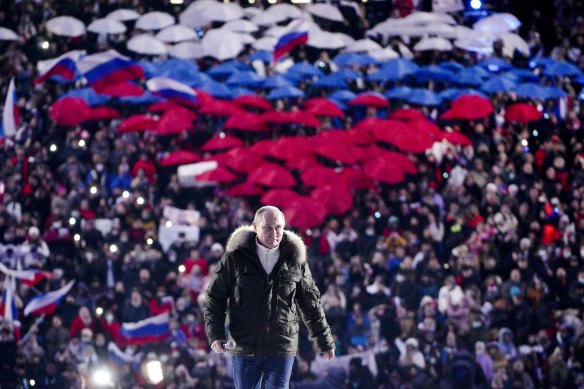
Russian President Vladimir Putin attends a concert in 2021 marking the seventh anniversary of the annexation of Crimea. Credit: AP
Let us explain
If you'd like some expert background on an issue or a news event, drop us a line at explainers@smh.com.au or explainers@theage.com.au. Read more explainers here.